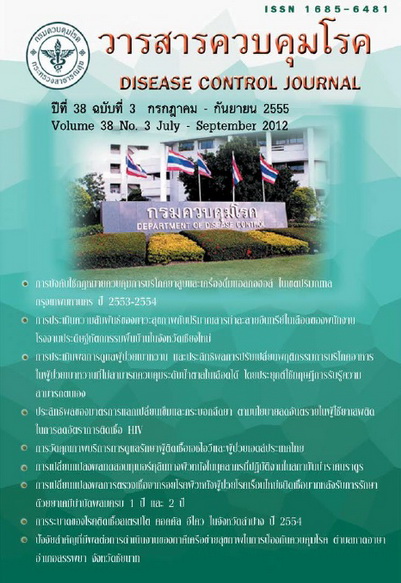Relationship between Health Status and Organic Solvent Level in Handicraft Workers in Chiangmai Province
Keywords:
Organic solvent, health status, handicraft workerAbstract
The aim of this study was to detect the blood level of organic solvents (Acetone, Isopropaanol, Toluene, Trichloroethylene and Hexane) in handicraft workers,Chiangmai province. In addition, the relationbetween blood solvents level and workers' health was determined. The subject categorized in exposed (n=150) and non-exposed group (n = 150) based on their self report questionaire. The exposed group was usually contact to organic solvent, while the non-exposure group was the same company worker but their job was not directly exposed or contact to organic solvent. Blood samples were collected at the end of morning shift.Organic solvents (parent compound) were detected by using Headspace-Gas Chromatography with Flame ionization detector (HS-GC-FID). Complete blood count, liver function test and kidney function test were also examined to determine a health status of workers. The result showed that the level of Trichloroethylene in exposed group was higher than non-exposed group (p<0.05). The relationship were shown on trichloroethylene level among number blood urea nitrogen (r = 0.67; p=0.038). In conclusion, the worker who exposed organic solvent during working found the trichloroethylene in blood and related to liver function so the data represent the deleterious effect of trichloroethylene exposure. The management of industry, working process and health surveillance of working who exposed to trichloroethylene is the most important especially informal workers which will be studied.
Downloads
References
2. ธนสร ตันศฤงฆาร, อนุสรณ์ รังสิโยธิน, บุญเทียม เทพพิทักษ์ศักดิ์, ณัฐวัฒน์ สุขทั่วญาติ. การเฝ้าคุมทางชีวภาพของพนักงานกลุ่มเสี่ยงที่รับสัมผัสสารอินทรีย์ระเหยง่ายในสถานบริการน้ำมันเชื้อเพลิง.วารสารการส่งเสริมสุขภาพและอนามัยสิ่งแวดล้อม ปีที่ 28 ฉบับที่ 4 หน้า 15-21. 2548
3. ศูนย์พัฒนาวิชาการในเขตอุตสาหกรรมภาคตะวันออก จ.ระยอง สำนักงานป้องกันควบคุมโรคที่ 3 จ.ชลบุรี กรมควบคุมโรค กระทรวงสาธารณสุข. คู่มือโรคจากสารตัวทำละลายอินทรีย์. กรมควบคุมโรค กระทรวงสาธารณสุข. นนทุบรี 2549.
4. วารุณี มะโณสงค์ ภาควิชาเคมี คณะวิทยาศาสตร์ มหาวิทยาลัยทักษิณ. http://linjah.exteen.com/20080829/headspace
5. Iffland R., Berghaus G. Experiences with Volatile Alcoholism Indicators (Method, Acetone, Isopropanol) in DWI Car Drivers. http://www.Drugiibraly.org/schaffer/Misc/driving/s3p4. 31 August 2004.
6. Wang G. et al. Blood acetone concentration in "normal people" and in exposed workers. International Archives of Occupational and Environmental Health. 2004; 258-9.
7. ประสงค์ คุณานุวัฒน์ชัยเดช และไมตรี สุทธิจิตต์. สารอินทรีย์ไอระเหยและสุขภาพ. พิษวิทยาสาร, ปีที่ 11 ฉบับที่ 4 ตุลาคม - ธันวาคม 2544 และปีที่ 12 ฉบับที่ 1 มกราคม - มีนาคม 2545, เชียงใหม่, 2545
8. วิไล ชินเวชกิจวานิชย์และคณะ. ความชุกของการได้รับโทลูอีนเข้าสู่ร่างกายของคนงานโรงงานผลิตสี:รายงานผลการวิจัย. http://thailis-db.car.chula. ac.th/CU_DC/October 2005/research/Vilai.pdf
9. Jain N.C. Direct Blood - Injection Method for Gas Chromatographic Determination of Alcohol and Other Volatile Compounds. Clinical chemistry 1971; 17:82-5.
10. Sunanta Wangharn and Jane Juntarasupasen. Analysis of some volatile organic compounds in soil sample using chromatography. Department
of Chemistry, Faculty of Science. Chiang Mai University, Chiang Mai 50200. Thailand
11. วนิดา คูอมรพัฒนะ http://www.eg.mahidol. ac.th/dept/egche/PDF/ANA/ANA10% 20Gas%20Chromatography.pdf
12. Agency for toxic substances and disease registry, www.atsdr.cdc.gov/toxprofiles/phs21.html 1/07/2010
13. มหาวิทยาลัยสุโขทัยธรรมาธิราช สาขาวิทยาศาสตร์สุขภาพ. เอกสารการสอนชุดวิชาพิษวิทยาและอาชีวเวชศาสตร์ 54106 . สำนักพิมพ์มหาวิทยาลัย สุโขทัยธรรมาธิราช, นนทบุรี 2552
14. ฉันทนา ผดุงทศ. คอลัมน์อาชีวเวชศาสตร์ปริทัศน์.วารสารคลินิก เล่ม 260; 08/2549
15. วิวัฒน์ เอกบูรณะวัฒน์. ฐานข้อมูลการดูแลผู้ป่วยที่ได้รับสารพิษเคมี (ThaiTox).mht.www.thaitox.com 7/6/2012
Downloads
Published
How to Cite
Issue
Section
License
Articles published in the Disease Control Journal are considered as academic work, research or analysis of the personal opinion of the authors, not the opinion of the Thailand Department of Disease Control or editorial team. The authors must be responsible for their articles.






